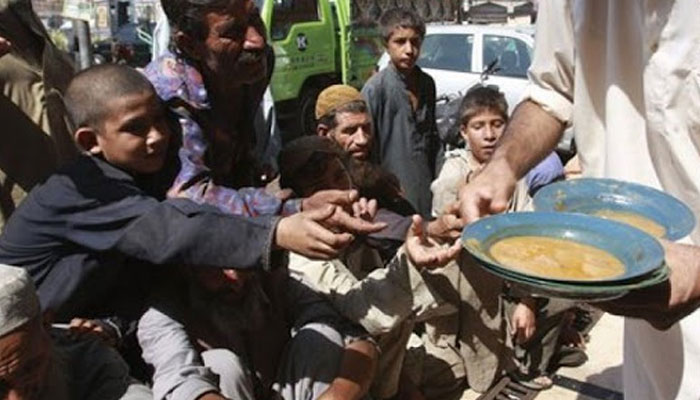Covid-19 : Survey shows 40pc households facing moderate or severe food insecurity
ISLAMABAD: Pakistan’s 40 percent households facing moderate or severe food insecurity in the aftermath of COVID-19 pandemic, a survey evaluating the socio-economic impact of coronavirus conducted by Pakistan Bureau of Statistics (PBS) revealed on Saturday.
A presentation on survey shows that Pakistan’s 60 percent households possessed adequate access to food in both quality and quantity. There are 30 percent households who are facing moderate food insecurity and uncertainties about their ability to obtain food, and have been forced to compromise on quality and quantity of the food they consume.
There are 10 percent households facing severe food insecurity. Such people are experiencing severe food insecurity, have typically run out of food and at worst gone a day or days without eating.
The coping strategies adopted by households included reduced non-food expenses i.e. health, clothing, etc, switched to lower quality/quantity food, spent savings or investment or sold property, obtained loans from friends/relatives, delayed payment of loans and in severe cases. There were about 8 percent households who were forced to discontinue education.
The survey results shows that total 160 million population is affected for lockdown as 55.74 million population is affected in pre-Covid-19 situation from Jan-March 2019, about 35.04 million is affected during COVID-19 period from April-July and 52.56 million is affected in post-Covid-19 period from August to October 2020.
The situation analysis of working population affected due to lockdown stood at 27.31 million, job loss/could not work due to lock down 20.6 million and 6.7 million faced decrease in their income.
The affected working population by industry showed that 26 percent belonged to manufacturing sector, 20 percent construction sector, 17 percent transport and storage, 16 percent wholesale and retail trade and others 5 percent.
There were 17.07 million households affected out of which 49 percent belonged to rural areas and 57 percent from urban areas. The affected working population by industry in terms of incidence belonged to 80 percent from construction sector.
The survey made some major recommendations including the casual workers; piece rate workers and self employed (Non-Agriculture) are the most vulnerable. Mechanism for provision of social protection measures may be devised for these vulnerable groups.
Most affected sectors are manufacturing, construction and transport, although recovery has been observed but these sectors need continued policy support for sustaining their recovery.
-
 Alexander Skarsgard Breaks Silence On Rumors He Is Bisexual
Alexander Skarsgard Breaks Silence On Rumors He Is Bisexual -
 King Charles Faces Rift With Prince William Over Prince Harry’s Invictus Games
King Charles Faces Rift With Prince William Over Prince Harry’s Invictus Games -
 Elon Musk’s Critique On ChatGPT Safety Draws Sharp Response From Sam Altman
Elon Musk’s Critique On ChatGPT Safety Draws Sharp Response From Sam Altman -
 Katherine Ryan Takes Aim At Brooklyn Beckham In Fierce Defense Of His Parents
Katherine Ryan Takes Aim At Brooklyn Beckham In Fierce Defense Of His Parents -
 How Timothy Busfield, Melissa Gilbert Really Feel After Release From Jail
How Timothy Busfield, Melissa Gilbert Really Feel After Release From Jail -
 OpenAI, Bill Gates Launch ‘Horizon 1000’ To Transform AI Healthcare In Africa
OpenAI, Bill Gates Launch ‘Horizon 1000’ To Transform AI Healthcare In Africa -
 Prince Harry Receives Praises For Exposing Dark Side Of British Tabloids
Prince Harry Receives Praises For Exposing Dark Side Of British Tabloids -
 Andrew Forces Beatrice, Eugenie To Lose $60 Million Safety Net Saved For Retirement
Andrew Forces Beatrice, Eugenie To Lose $60 Million Safety Net Saved For Retirement -
 Nvidia CEO Jensen Huang To Visit China To Push Re-entry Into AI Chip Market
Nvidia CEO Jensen Huang To Visit China To Push Re-entry Into AI Chip Market -
 U.S. On Verge Of Losing Measles-free Title Due To Outbreak
U.S. On Verge Of Losing Measles-free Title Due To Outbreak -
 Harry Styles Excites Fans As He Announces Release Date Of New Song
Harry Styles Excites Fans As He Announces Release Date Of New Song -
 Japan’s Ex-PM Shinzo Abe’s Killer Is Set To Be Sentenced: How Much Punishment Could He Face?
Japan’s Ex-PM Shinzo Abe’s Killer Is Set To Be Sentenced: How Much Punishment Could He Face? -
 Prince Harry, Meghan Markle’s Return To UK Could Create Royal Family Dilemma
Prince Harry, Meghan Markle’s Return To UK Could Create Royal Family Dilemma -
 Prince Harry Turns Troubled With No Sense Of Home: ‘Isolation Is Getting To Him Mentally’
Prince Harry Turns Troubled With No Sense Of Home: ‘Isolation Is Getting To Him Mentally’ -
 Vitamin D Link To Respiratory Diseases Will Shock You
Vitamin D Link To Respiratory Diseases Will Shock You -
 A$AP Rocky Gives His Take On Children's Budding Personalities
A$AP Rocky Gives His Take On Children's Budding Personalities




